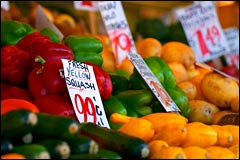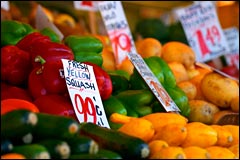Kathy Webb stands in front of a group of 20 people in the dining room of her Asian restaurant, talking about locally grown food. As she describes how nearly all the ingredients in the five-course dinner she’s about to serve — from the tomatoes and herbs in the salad to the berries in the dessert — are from Arkansas, she educates her listeners while whetting their appetites.
Webb, a newly elected state legislator and owner of Lilly’s Dim Sum, Then Some in Little Rock, says a connection to food is something Americans have lacked over the last several decades. “When you know who has picked your peach, when you know the story about that peach, you will appreciate it and have a connection to that peach,” Webb says. “That’s important. We don’t have that connection to food anymore, but we need to, and we need to know where our food comes from.”

So, you from around here?
Photo: iStockphoto
It’s people like Webb who have begun to ask whether the produce they buy at the Little Rock farmers’ market is serving that purpose. That’s because the market, unlike many in the U.S., allows vendors who don’t grow their own produce to sell products — most of which come from outside the state. And that doesn’t sit well with local farmers.
This summer, farmers who rent stalls twice a week at the downtown market have questioned why “peddlers” — as the farmers call them — are allowed to sell the same produce they do: tomatoes, cantaloupes, watermelons. The peddlers’ items are cheaper and come from boxes marked as originating in Georgia, California, Mexico, and points in between, not rural Arkansas. Farmers who spend hours babying their crops believe this is misleading to consumers who think they are supporting local farmers and stimulating the local economy by shopping at the market.
Several farmers — including Christian Shuffield, who grows organic and biodynamic specialty greens and legumes, and Jody Hardin, a well-known Arkansas farmer and a fixture at the market — are tired of the unfair playing field. “Is this a farmers’ market or a global bazaar?” Hardin asks. “Peddlers are lying, saying they have gardens. That is irritating. They don’t put any money into growing their product.”
Shuffield agrees. “The commercial vendors don’t have overhead like diesel or labor,” he says. “It’s important to buy locally for the farmers’ benefit.”
Both say it is hard to educate people to buy locally when consumers see imported produce at a farmers’ market, just as they do on the grocery store shelf. So they approached Shannon Light, the market’s manager, to discuss changes. Since the 15,000-square-foot pavilion that hosts the market is so vast, Light responded by moving Arkansas farmers to one end, peddlers to the other. Now Arkansas farmers have signs promoting their Arkansas produce.
But the farmers say this isn’t enough. And they worry that some peddlers may still be passing themselves off as local farmers because they sell a few items grown in-state, even though many of their wares come from fsrther afield. Light admits she doesn’t know how many of the 200 registered vendors are actually Arkansas farmers; she doesn’t “exactly divide them that way,” she says. And she doesn’t seem to care much about the distinction. She says there is room for everyone in what she describes as “the special event I am having … like a little circus.” Indeed, the market under her management is more akin to a yuppie street fair featuring mimes and bongo players than a down-home event.
“Some people don’t care about buying local, they just want fresh,” Light says. “[The peddlers] wouldn’t be bringing watermelons in May if it wasn’t selling. It’s profitable and something that people want. If you are dipping strawberries and you can get big and beautiful ones from California while buying your winter squash, you should go ahead and get them for your party on Tuesday.”
But Arkansas farmers raise strawberries, too, says Hardin, and he has seen his profit cut on seasonal produce because peddlers sell it a week before he does. “As farmers, we need a pent-up demand for a product,” he says. “We need people anxious to get it when it comes in season. We can’t sell as much because the peddlers are competing. Other farmers will bring in California strawberries, and it kills the demand.”
Not From My Back Yard
Should a farmers’ market offer only locally grown items? Many people who care about good food and a healthy environment say yes, especially as concerns mount about fuel costs and food miles, or the distance food travels before it reaches your mouth.
A farmers’ market conjures up images of mom-and-pop operations that load up the pickup truck with homegrown squash, tomatoes, and eggplants and deliver them to the city for urbanites to buy without a middleman. While local doesn’t necessarily mean organic, it does mean fresh, not transported thousands of miles before reaching its buyer. According to California-based Local Harvest, a national directory of farms and farmers’ markets, most produce in the U.S. is picked four to seven days before it is placed on supermarket shelves, and is shipped an average of 1,500 miles before it is sold. It takes even longer if the produce comes from outside the country.
“What is happening in Arkansas would never happen in California,” says Guillermo Payet, president of Local Harvest. California has a certification program for farmers’ markets, which allows only in-state growers. The United Kingdom has a similar program. But in Arkansas, as in many other states, each local community polices itself.
Some never strayed from strict rules. The market in Fayetteville, Ark., which began in 1974, allows only farmers who live and grow within a four-county area to sell. Even artisans who sell crafts in the market must follow the same rules. The same type of guidelines apply to the market in Boulder, Colo. The market in Portland, Ore., after which the Little Rock market modeled itself, allows products from throughout the state as well as neighboring Washington, but makes few other exceptions.
The Little Rock market began the same year as its counterpart in Fayetteville, in a downtown parking garage. Then, the farmers governed themselves and “enforced a producer-only rule and allowed only the sale of Arkansas-grown produce,” according to a 1999 USDA review of the market.
In 1996, the operation moved to a wood-and-steel pavilion in the heart of the $300 million revitalized and tourist-driven River Market District near the William J. Clinton Presidential Museum and Park. At that point, the rules were relaxed to include out-of-season produce and exotics such as pineapples and avocados that cannot be grown in Arkansas. As the USDA review noted, “consumer favorites such as melons, peaches, greens, and tomatoes from outside the state may be sold at the market when locally unavailable.”
A Matter of Scale
Between 1994 and 2004, the number of farmers’ markets in the U.S. increased 111 percent, from 1,755 to 3,706, according to the USDA. Arkansas has almost 50 markets. Across the country, those figures are expected to keep rising over the next decade.
James Howard Kunstler, author of The Long Emergency, says farmers’ markets could be the only viable alternative in a world forced to be less dependent on oil. “We are going to have huge problems feeding ourselves as the world slips into a permanent global energy crisis,” he says. “Industrial-style agriculture, featuring giant farms and heavy applications of oil-and-gas-based soil ‘inputs’ and massive use of diesel fuel, is going to fail — and sooner rather than later. We are going to have to grow much more of our food locally, and on a smaller, finer scale. The people who are doing that now must be supported. Your lives will depend on them a few years from now.”
Ronnie Cummins, national director of the Organic Consumers Association, also predicts a throwback to the 1940s, when people tended victory gardens in their backyards. “If we are going to stabilize the climate and have an adequate food supply, we are going to have to go back to the way it was,” he says. “That means also eating seasonal.”
Arkansas, with its vast farmland and mild seasons, is in a prime spot to make this happen. Agriculture is the state’s leading industry, thanks mostly to major crops such as rice, soybeans, and cotton. While it has its share of factory farms and vegetable producers, including the mammoth Riceland Rice, the state is also home to thousands of small farmers who want to make a living — however modest — by doing what they love.
According to the USDA, those who benefit from farmers’ markets are small farmers with less than $250,000 in annual gross receipts who work and manage their own operations. Local Harvest points out that only 18 cents of every dollar from sales at large supermarkets go to the grower, with the balance going to various unnecessary middlemen.
Hardin would like to see Little Rock’s city board of directors bar out-of-state produce from the farmers’ market. He says that because of the controversy over who’s permitted to sell at the market, more farmers are looking for alternative venues. That leaves only a small core to fight the peddlers.
While the city is likely to leave the resolution of this issue to those who manage the market, farmers might get help from the state. Richard Bell, secretary of the recently created Arkansas Department of Agriculture, says there is a need to closely examine farmers’ markets. He suggests that some sort of future legislation could address the issues that worry farmers like Hardin.
“My goal is to increase the amount of produce that is coming from small Arkansas farms,” Bell says. “A good part of a farmers’ market is a good economic development plan. It is a way of providing an amenity to people in your community, and I do think we need some more formalized guidelines to make that work.”


